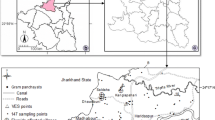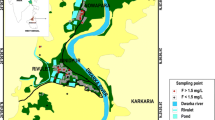Abstract
Fluoride (F–) pollution in groundwater of the Older Alluvial Plain (OAP) of Delhi has been reported as a major problem. About 34% of the groundwater samples collected for this study had F– level beyond the permissible limit; with F– concentration in the range of 0.14–3.15 mg/L (average 1.20 mg/L). In this context, this article for the first time attempts on the genesis of major ions chemistry and F– pollution in groundwater of OAP Delhi by going beyond the statistical analysis to sediment geochemistry, chemical weathering processes and understanding of the processes using stable environmental isotopes (2H and 18O). The XRD of the OAP sediments revealed the dominance of fluor-biotite, albite, calcite, quartz, and chlorite. Whereas, the separated clay revealed the dominance of chlorite, kaolinite, and illite minerals. The saturation index (SI) values indicated that the groundwater chemistry is in the process of further F– enrichment by way of sediment groundwater interaction. With the given mineralogy of the sediments, the dominance of major ions like Na+, K+, Mg2+, Ca2+, Cl– and F– has been attributed to chemical weathering of biotites, phlogopites, albite, and calcite during sediment–water interaction. While the dominance of SO42– has been attributed to anthropogenic sources and confirmed by its association with heavier stable isotopes of hydrogen (δ2H: −50.44 to −40.02‰) and oxygen (δ18O: −7.19 to −5.62‰) indicating evaporative enrichment during isotopic fractionation.









Similar content being viewed by others
References
Ali S, Thakur S K, Sarkar A and Shekhar S 2016 Worldwide contamination of water by fluoride; Environ. Chem. Lett. 14 291–315, https://doi.org/10.1007/s10311-016-0563-5.
Ali S 2017 Fluoride contamination and major ions chemistry of groundwater in NCT Delhi, India, Unpublished M.Phil. thesis submitted to University of Delhi.
Ali S, Shekhar S, Bhattacharya P, Verma V, Chandresekhar T and Chandrashekhar A K 2018 Elevated fluoride in groundwater of Siwani Block, Western Haryana, India: A potential concern for sustainable water supplies for drinking and irrigation; Groundw. Sustain. Develop. 7 410–420, https://doi.org/10.1016/j.gsd.2018.05.008.
Ali S, Fakhri Y, Golbini M, Thakur S K, Alinejad A, Parseh I, Shekhar S and Bhattacharya P 2019 Concentration of fluoride in groundwater of India: A systematic review, meta-analysis and risk assessment; Groundw. Sustain. Develop., https://doi.org/10.1016/j.gsd.2019.100224.
BIS 2012 Indian Standard Specification for drinking water, B.S.10500.
Biswas A, Nath B, Bhattacharya P, Halder D, Kundu A K, Mandal U, Mukherjee A, Chatterjee D, Mörth C M and Jacks G 2012 Hydrogeochemical contrast between brown and grey sand aquifers in shallow depth of Bengal Basin: Consequences for sustainable drinking water supply; Sci. Total Environ. 431 402–412.
Census of India 2011 Available at https://censusindia.gov.in/.
Chatterjee R, Gupta B K, Mohiddin S K, Singh P N, Shekhar S and Purohit R 2009 Dynamic groundwater resources of National Capital Territory, Delhi: Assessment, development, and management options; Environ. Earth Sci. 59 669–686.
Craig H 1961 Standard for reporting concentrations of deuterium and oxygen-18 in natural water; Science 133 1833–1834.
Das B K, Kakar Y P, Moser H and Stichler W 1988 Deuterium and oxygen-18 studies in groundwater of the Delhi area, India; J. Hydrol. 98(1–2) 133–146.
Datta P S, Tyagi S K and Chandrasekharan H 1991 Factors controlling stable isotope composition of rainfall in New Delhi, India; J. Hydrol. 128(1–4) 223–236.
Datta P S, Deb D L and Tyagi S K 1996 Stable isotope (18O) investigations on the processes controlling fluoride contamination of groundwater; J. Contam. Hydrol. 24(1) 85–96.
Datta P S and Tyagi S K 1996 Major ion chemistry of groundwater in Delhi area: Chemical weathering processes and groundwater flow regime; J. Geol. Soc. India 47 179–188.
Dehbandi R, Moore F and Keshavarzi B 2018 Geochemical sources, hydrogeochemical behaviour, and health risk assessment of fluoride in an endemic fluorosis area, central Iran; Chemosphere 193 763–776.
Dissanayake C B and Chandrajith R 2017 Groundwater fluoride as a geochemical marker in the etiology of chronic kidney disease of unknown origin in Sri Lanka; Ceylon J. Science 46(2) 3–12, https://doi.org/10.4038/cjs.v46i2.7425.
Eriksson E 1976 The distribution of salinity in groundwater of the Delhi region and recharge rates of groundwater; In: Interpretation of environmental isotope and hydrochemical data in groundwater hydrology, Proc. Advisory Meeting, Vienna 1975, IAEA, pp. 171–177.
Esteller M V, Kondratenko N, Expósito J L, Medina M and del Campo M M 2017 Hydrogeochemical characteristics of a volcanic-sedimentary aquifer with special emphasis on Fe and Mn content: A case study in Mexico; J. Geochem. Explor. 180 113–126.
Guo Q, Wang Y, Ma T and Ma R 2007 Geochemical processes controlling the elevated fluoride concentrations in groundwaters of the Taiyuan Basin, Northern China; J. Geochem. Explor. 93 1–12, https://doi.org/10.1016/j.gexplo.2006.07.001.
Jacks G, Bhattacharya P, Chaudhary V and Singh K P 2005 Controls on the genesis of some high-fluoride groundwaters in India; Appl. Geochem. 20(2) 221–228.
Joshi S K, Rai S P, Sinha R, Gupta S, Densmore A L, Rawat Y S and Shekhar S 2018 Tracing groundwater recharge sources in the northwestern Indian alluvial aquifer using water isotopes (δ18O, δ2H and 3H); J. Hydrol. 559 835–847.
Kashyap C A, Ghosh A, Singh S, Ali S, Singh H K, Chandrasekhar T and Chandrasekharam D 2020 Distribution, genesis and geochemical modeling of fluoride in the water of tribal area of Bijapur district, Chhattisgarh, central India; Groundw. Sustain. Develop. 100403, https://doi.org/10.1016/j.gsd.2020.100403.
Kullerud K 2000 Occurrence and origin of Cl-rich amphibole and biotite in the earth’s crust – implications for fluid composition and evolution; In: Hydrogeology of crystalline rocks, Springer, Dordrecht, pp. 205–225.
Kumar S, Sarkar A, Ali S and Shekhar S 2018 Groundwater System of National Capital Region Delhi, India; In: Groundwater of South Asia. Springer Hydrogeology (ed.) Mukherjee A, Springer, Singapore, pp. 131–152, https://doi.org/10.1007/978-981-10-3889-1_9.
Kumar P S, Jegathambal P, Nair S and James E J 2015 Temperature and pH dependent geochemical modeling of fluoride mobilization in the groundwater of a crystalline aquifer in southern India; J. Geochem. Explor. 156 1–9.
Kumar M, Ramanathan A L, Rao M S and Kumar B 2006 Identification and evaluation of hydrogeochemical processes in the groundwater environment of Delhi, India; Environ. Geol. 50(7) 1025–1039.
Li P, He X, Li Y and Xiang G 2018 Occurrence and health implication of fluoride in groundwater of loess aquifer in the Chinese Loess Plateau: A case study of Tongchuan; Expo. Health, Northwest China, https://doi.org/10.1007/s12403-018-0278-x.
Lorenzen G, Sprenger C, Baudron P, Gupta D and Pekdeger A 2012 Origin and dynamics of groundwater salinity in the alluvial plains of western Delhi and adjacent territories of Haryana State, India; Hydrol. Process. 26(15) 2333–2345.
Mor S, Singh S and Yadav P et al. 2009 Appraisal of salinity and fluoride in a semi-arid region of India using statistical and multivariate techniques; Environ. Geochem. Health 31(6) 643–655, https://doi.org/10.1007/s10653-008-9222-5.
Mukherjee I and Singh U K 2018 Groundwater fluoride contamination, probable release, and containment mechanisms: A review on Indian context; Environ. Geochem. Health 40 2259, https://doi.org/10.1007/s10653-018-0096-x.
Piper A M 1944 A graphical procedure in the geochemical interpretation of water analysis; Trans. Am. Geophys. Union 25 914–923.
Podgorski J E, Labhasetwar P, Saha D and Berg M 2018 Prediction modeling and mapping of groundwater fluoride contamination throughout India; Environ. Sci. Technol. 52(17) 9889–9898.
Saha D, Shekhar S, Ali S, Elango L and Vittala S 2020 Recent Scientific Perspectives on the Indian Hydrogeology; Proc. Indian Natl. Sci. Acad. 86(1) 459–478.
Saha D, Shekhar S, Ali S, Vittala S S and Raju N J 2016 Recent hydrogeological research in India; Proc. Indian Natl. Sci. Acad. 82(3) 787–803, https://doi.org/10.16943/ptinsa/2016/48485.
Sarkar A, Shekhar S and Rai S P 2017 Assessment of the spatial and temporal hydrochemical facies variation in the flood plains of North–West Delhi using integrated approach; Environ. Earth Sci. 76(19) 665.
Sarkar A, Ali S, Kumar S, Shekhar S and Rao S V N 2016 Groundwater environment in Delhi, India. Groundwater Environment in Asian Cities: Concepts, Methods and Case Studies, 1st edn, Elsevier Inc., pp. 77–108.
Sarkar A and Shekhar S 2015 The controls on spatial and temporal variation of hydrochemical facies and major ion chemistry in groundwater of South West District, Delhi, India; Environ. Earth Sci. 74(12) 7783–7791.
Sett D N 1964 Groundwater geology of the Delhi region; Bull. Geol. Surv. India Ser. B 16 1–35.
Shekhar S and Sarkar A 2013 Hydrogeological characterization and assessment of groundwater quality in shallow aquifers in vicinity of Najafgarh drain of NCT Delhi; J. Earth Syst. Sci. 122(1) 43–54, https://doi.org/10.1007/s12040-012-0256-9.
Shekhar S, Mohiddin S K and Singh P N 2009 Variation in concentration of fluoride in the groundwater of south-west district, NCT Delhi – A case study; Assess. Groundw. Resour. Manag., 370–376.
Singh C K, Kumar A, Shashtri S, Kumar A, Kumar P and Mallick J 2017 Multivariate statistical analysis and geochemical modeling for geochemical assessment of groundwater of Delhi, India; J. Geochem. Explor. 175 59–71.
Thussu J L 2006 Geology of Haryana and Delhi; Geological Society of India, Bangalore.
WHO 2011 Guidelines for drinking-water quality, 4th edn. World Health Organization, Geneva, www.who.int.
Vithanage M and Bhattacharya P 2015 Fluoride in the environment: Sources, distribution and defluoridation; Environ. Chem. Lett. 13 131–147, https://doi.org/10.1007/s10311-015-0496-4.
Yadav A K 2018 Characterization of baseline arsenic value in groundwater of Delhi, Unpublished M.Phil. thesis submitted to University of Delhi.
Yousefi M, Ghoochani M and Mahvi A H 2018 Health risk assessment to fluoride in drinking water of rural residents living in the Poldasht city, Northwest of Iran; Ecotoxicol. Environ. Safety 148 426–430.
Acknowledgements
It is duly acknowledged that the present work is a part of the PhD of the first author (SA). The research is based on major ions data from unpublished MPhil dissertation of SA and AKY. Funding from the University of Delhi in the form of R&D project (2015–2016) to SS is duly acknowledged. SA and AKY acknowledge the non-NET fellowship provided by the University of Delhi. Thanks to Sachin Kumar Thakur for his support in analytical work. The authors would like to thank the editor and the reviewer for their scholarly comments, which helped in improving the manuscript.
Author information
Authors and Affiliations
Contributions
The work was conceptualized by SA and SS. The fieldwork for the study was done by SA and AKY. The sediment and water analysis were handled by SA, AKY, TC, NKA, SPR, and PP. The manuscript was initiated by SA in consultation with SS and technical inputs were provided by TC, AKY, CAK, PB, and DC. The final manuscript was written in a series of joint seating by SA and SS and at times joined by AKY.
Corresponding author
Additional information
Communicated by Dipankar Saha
Publisher's note
Springer Nature remains neutral with regard to jurisdictional claims in published maps and institutional affiliations.
Supplementary material pertaining to this article is available on the Journal of Earth System Science website (http://www.ias.ac.in/Journals/Journal_of_Earth_System_Science).
Supplementary Information
Rights and permissions
About this article
Cite this article
Ali, S., Shekhar, S., Chandrasekhar, T. et al. Influence of the water–sediment interaction on the major ions chemistry and fluoride pollution in groundwater of the Older Alluvial Plains of Delhi, India. J Earth Syst Sci 130, 98 (2021). https://doi.org/10.1007/s12040-021-01585-3
Received:
Revised:
Accepted:
Published:
DOI: https://doi.org/10.1007/s12040-021-01585-3




